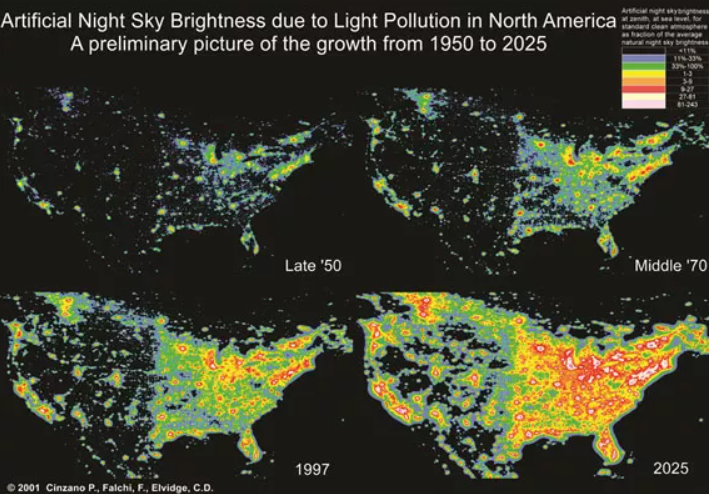Educational 14 November 2024
What do you see when you look up at the sky at night? If you’re like most people living in or near an urban center, chances are, it’s not much. Scientists have found that only 20% of Americans can see the Milky Way from their homes.
That’s because light pollution, or the brightening of the night sky by artificial light sources like streetlights, buildings, and billboards, has created a luminous glow around much of the planet that effectively masks the stars and planets.
It’s not just our nighttime vistas that are impacted. Light pollution has severe consequences for wildlife, human health, and the environment, including a massive amount of wasted energy generated from fossil fuels.
Fortunately, there are ways to reduce the amount of light we send into the atmosphere and limit these harmful effects. In this article, we’ll share how to light responsibly so that you can enjoy the many benefits of outdoor nighttime lighting without contributing to the problem.
According to DarkSky International, the worldwide authority on night sky preservation and protection, light pollution is the human-made alteration of outdoor light levels from those occurring naturally. The problem isn’t artificial light itself, but rather how and when it’s used and where it’s directed.
There are three components to light pollution: trespass (light falling where it’s not wanted or needed), glare (intense brightness that causes visual discomfort and reduces visibility), and clutter (bright, confusing groupings of light). Together, they create sky glow, or the overall brightening of the night.
Part of the reason is simply that the world’s population is growing. According to the United Nations, there are more than three times more people on the planet now than in the mid-20th century, and those people—and the offices, factories, and homes that accompany them—are collectively emitting more light.
Another reason is that lighting technology has improved. While we often consider LEDs’ efficiency and longevity an advantage, they can be a double-edged sword. Because they are cheaper than their predecessors, residents, businesses, and municipalities use more of them and are more apt to leave them on when they are not needed.

This map simulates the growth of light pollution in the U.S. from the late 1950s to today. More than 80% of Americans now live under skyglow, making it difficult to see more than a handful of stars at night.
It might sound like an exaggeration, but light pollution really does affect everyone and everything. From insect species like fireflies that rely on bioluminescent cues to find mates to sea turtle hatchlings that use the moon’s reflection to orient themselves to the ocean, creatures big and small have evolved around the predictable cycles of light and dark, day and night.
Even humans, who are diurnal or active during the day, need darkness to regulate their hormones and steady their circadian rhythm. Increased exposure to light at night has been shown to lower melatonin production, resulting in sleep deprivation, stress, anxiety, and a range of other health issues.
Plenty! Light pollution is a human-made problem, which means its well within our capacity to fix it. Whether you’re an engineer working on a streetlight replacement project or a landscape architect looking to light a new park, here are some things you can do to minimize light pollution and restore the night sky.
When you’re lighting a street, park, or pathway, there are the objects and areas you want to illuminate, and then there’s everywhere else that light tends to spill into: people’s homes, yards, parklands, and, of course, the sky.
Fortunately, there’s a simple solution: Dark Sky-friendly fixtures that have a full cut-off or use shielding to direct the light downward. The IES has developed a rating system—called BUG, for Backlight, Uplight, and Glare—that can help you quantify how much light a fixture emits in each direction. An Uplight rating of 0 is required to be Dark Sky.
Most lighting applications don’t require bright light round-the-clock. For example, if you’re lighting a parking lot for a shopping complex that opens at 9 a.m. and closes at 6 p.m., you may only want to keep it fully lit for a few hours before opening in the morning and a few hours after closing at night.
This is where dimming comes in, allowing you to program your lights so they’re not operating at full brightness—and consuming full-brightness energy—when they don’t need to be. You can also consider using motion sensors that turn on the lights when activity is detected and dim or turn them off when no one’s around.
Shielding and scheduling are important, but we also know that the color of light is key to protecting the health of humans and wildlife.
While the first LED lights had a color temperature of 8,000K, meaning they emitted more than 45% blue light and were harsh on the eye, advances in LED technology have brought this down to a much warmer 3,000K. Warmer whites, yellows, and even reds are less disruptive to people and animals, so go warm if you can.
Dark Sky International has a wealth of resources and programs focused on protecting the night sky, including its International Dark Sky Places Program, which currently comprises over 130 communities, parks, and protected areas committed to responsible lighting policies and public education.
And if you’re interested in embracing Dark Sky principles on your next lighting project, we can help! We offer a variety of compliant fixtures and can help advise on the best lighting profile to maximize safety and minimize pollution.
